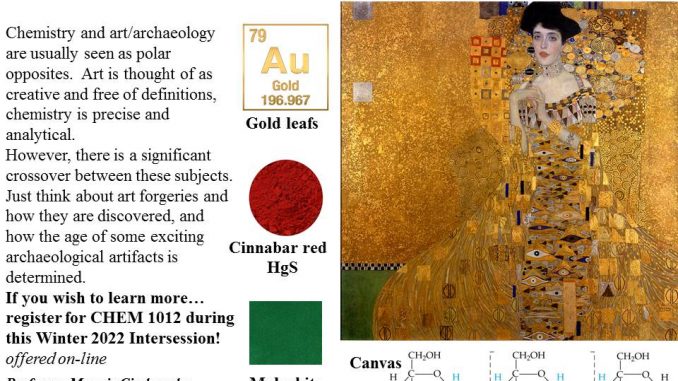
By Michela Arlia
A new course is coming to BC’s roster this winter which combines two seemingly polar opposite subjects, but actually have more in common than one may think.
“CHEM. 1012: Chemistry In the Arts and Archaeology” will be taught online during the winter intersession for the first time as an option that satisfies students’ “Pathways Flexible Core Scientific World” requirement. Taught by Chemistry Professor Maggie Ciszkowska, the course sheds light on how the arts and science worlds collide.
“I just wanted to share my fascination with chemistry with those who probably only thought about it as an unpleasant school subject,” Ciszkowska told The Vanguard.
For nearly 25 years, Ciszkowska has been teaching at Brooklyn College, having once held the title of department chair for 9 years. Creating this course is something she has looked forward to sharing with students for a long time.
While the course is new to BC in Pathways requirements, Professor Ciszkowska is no stranger to teaching the course, as she created it herself, calling it her “baby. She has taught it once before for the Brooklyn College Honors Academy in Fall 2020, and is currently teaching it as a seminar for the Macaulay Honors College students this semester.

” She taught the class once before for the Brooklyn College Honors Academy in fall 2020 and is currently teaching it as a seminar for the Macaulay Honors College students this semester.
“It was born in my head many years ago, and it was waiting for its introduction to a wider audience for several years,” said Ciszkowska.
Ciszkowska first thought of the course after meeting colleagues from the Swiss Federal Laboratories for Materials Testing and Research, who analyzed paintings from the 16th and 17th centuries using chemical analytical methods.
With her research background being in analytical chemistry, Ciszkowska was intrigued by the use of chemistry to study art and create a scientific tie to classic pieces.
“It was fascinating that while being chemists, they had a chance to get so close to these masterpieces, and they were able to find from where some of the pigments (mainly lead white) used in those painting came,” she said.
Though her long-standing focus in academia is chemistry, it was her second love of the arts and art history that propelled Ciszkowska to teach this course.
“Chemistry has been my ‘love’ from the 7th grade when I first took chemistry classes in my native Poland. As for the arts, I have the misfortune of not being able to draw or paint,” Ciszkowska said, noting that she remains an art fanatic nonetheless.. “So, the idea of showing how artists use chemical compounds in their work, how they apply chemical techniques to achieve beautiful visual effects, and how chemical techniques are helping in authentication of art pieces was extremely appealing.”
Since teaching her course, Ciszkowska said she has received nothing but positive comments from past students, which makes her hopeful the class will be just as enjoyable for all BC students choosing it for Pathways.
“I was told by my students that their favorite subject of this course is the part on art forgeries and art authentication,” said Ciszkowska. “Here, a chemist plays the role of a detective.”
In creating this course, Ciszkowska made it possible for it to appeal to many students from different academic backgrounds such as chemistry majors, students who have never taken a chemistry course, art historian buffs, and everyone in between.
“While designing this course, I was trying to make it both interesting and understandable to all students,” she said. “I trust that all of them will learn a lot and that after finishing this course, they will become real ‘ambassadors’ of chemistry, as this part of science that is really interesting and useful.”
As for how the course will incorporate art and chemistry exactly? Take for instance the “Portrait of Adele Bloch-Bauer” by Gustav Klimt and all its properties that compose it, Professor Ciszkowska explained.
“Not too many of us look at it and think, ‘What a fantastic diversity of chemical compounds,’” said Ciszkowska. She notes how every aspect of the renowned painting, from its canvas to its oil paints are composed of different properties, including the gold metals attached to its surface along the Lady in Gold. “So, by using one painting, I can introduce students to many scientific ideas such as atoms, ions, chemical compounds, polymers and many, many other chemical concepts.”
Ciszkowska is very excited to be offering this course to any and all BC undergrads this winter, hoping to continue teaching the course at least once per semester.
“Perhaps it is too much to wish for, but I really would like my students to become as fascinated with both chemistry and art as I have been for many, many years,” she said.
